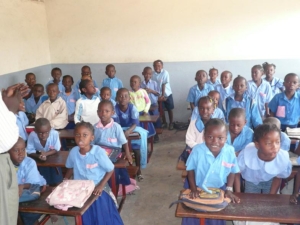Child Soldiers in the Democratic Republic of the Congo

Belgium colonized the Democratic Republic of the Congo (DRC) for 80 years until the country was able to gain its rightful independence in 1960. Belgian rule allowed the use of torture in particular to political opponents, causing instability from the ground up that has stayed with the country even as it became a democratic nation. History has shown how difficult it is for countries to prosper once colonized and the Congo is unfortunately no different. Both internal struggles for power and outside conflicts have hindered the country for decades, and the most vulnerable group is feeling it the worst — children. Child Soldiers in the Democratic Republic of the Congo are nothing new, but the country is actively working to change that. One of the largest hurdles facing this issue is the extreme level of poverty in the country, where nearly 80% of citizens survive on less than $2 per day.
Congolese Politics
The DRC has had many instances of political violence, but the 1990s were a turning point. After seizing power in 1965, President Mobutu took control and ruled until he was overthrown in 1997. Former President Laurent Kabila took control and suspended the democratic process before he himself was assassinated a few years later. It was not until 2006 that democratic policies were reinstituted, but the internal conflicts of the past still remain today, including ethnic nationalism and tribalism throughout the region. The DRC is one of the poorest countries in the world. This poverty and constant internal conflict for power leave so many displaced, opening the door for child soldiers to be recruited and taken advantage of. With consistent instability, often the most at-risk groups feel the weight of the tension the most.
Child Soldiers
Children as young as 6 find themselves routinely recruited to join militia groups, though the most common ages range from 8-16. There are varying positions they are forced to work including spies and messengers. Other child soldiers in the DRC find themselves fighting on the front lines for differing warlords.
The UN has found militias operating in the DRC have a “staggeringly high number of violations against children.” They prey on children using patriotism as motivation or by taking advantage of the extreme level of poverty in the country. Government forces, who once also implemented child soldiers, have to shoulder some of the blame, as attacks on schools and hospitals have risen as well.
The U.S. Department of State provides a report to explain and understand how child soldiers are being implemented in the DRC while also showing the best estimation of child soldier numbers. The Trafficking in Persons (TIP) report lists the DRC as a Tier 2 country on a 3-tier system. Tier 2 countries are those that have not eliminated trafficking but are making “significant efforts” to do so.
Solutions and Progress
The United States passed a law in 2008 that allows for the withholding of military aid to governments that use children in their armed forces, called the Child Soldiers Prevention Act. At the time, the Congolese government was still using child soldiers, but this act directly changed that. After its passing, the DRC signed a U.N. action plan that made certain guarantees leading to the end of its recruitment and use of child soldiers. Further penalties stem from TIP if a country is listed on Tier 3, which opens the door for U.S. sanctions.
The government of the DRC has taken further action against militia groups that are still involved by showing an increase in trafficking probes and prosecutions once caught. They have also removed children from these armed groups while agreeing with militia commanders on ending child recruitment, getting some to even renounce the practice altogether. That is quite an improvement in a country where this has taken place for decades.
NGOs are operating in the country, including Mercy Corps, which is finding ways to help the government economically that in turn, help the citizens of the DRC. Mercy Corps is addressing basic needs by piping in clean water and building wash stations. It has also proposed strategies that are designed to tackle poverty by repairing economic relations with other African countries that are facing the same violence. Another path is using the Congo’s massive amount of natural resources, both diamonds and gold and refining them at home.
There are still thousands of child soldiers in the Democratic Republic of the Congo being used as spies and messengers. There are programs being implemented to bring change in this area, by both the Congolese government and outside NGOs. Further outside help is being provided by foreign countries that have incentive programs to counteract child soldier use. The number of child soldiers is down, but without continued help to alleviate a major cause, extreme poverty, the threat of being forced to fight in armed conflicts will remain.
– Benett Crim
Photo: Wikimedia Commons
